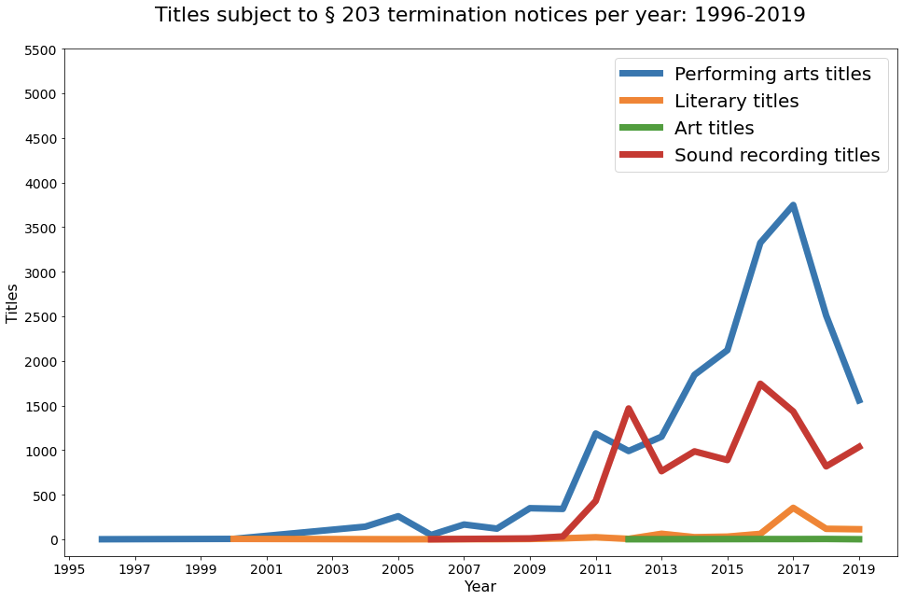Joshua Yuvaraj, Author’s Interest Project, (CC-BY-ND) Link
We’re delighted to announce that our latest research, a whole-of-universe study of copyright termination notices constructed from the US Copyright Office’s online catalogue, has been accepted for publication in the Journal of Empirical Legal Studies. Led by Joshua Yuvaraj and Rebecca Giblin of the Melbourne Law School, in collaboration with the Melbourne Data Analytics Platform and Associate Professor Genevieve Grant at Monash University, this is the first in-depth look into the real-world use of the U.S. copyright termination system.
This research examines Copyright Office records created each time someone files a notice of termination under §§ 203 or 304 of the Copyright Act. Those sections grant authors and their heirs inalienable rights to end copyright grants and reclaim their rights 35 years after transfer. They were designed to give authors a ‘second bite’ of the cherry, giving some redress in situations like that involving the co-creators of Superman (who sold their rights for just $130 in 1938). We constructed new open access datasets that contain all the termination notices we could locate in the catalog. Our research also analyses who is filing such notices and for what types of work, and how publishers, record companies, and other intermediaries respond when notices are filed against them.
Why it matters
Our data and analysis will inform ongoing discussions around the world for stronger creator protections in copyright law. In the EU, Canada, and South Africa, lawmakers have either recently implemented or are considering implementing new reversion rights (provisions giving authors entitlements to reclaim their rights). These proposals are meant to push back against often one-sided rights contracts authors often find themselves in, across a range of creative industries, and promise benefits to book authors, recording artists and songwriters among others. Reversion rights have great potential to help better achieve copyright’s goals: to reward authors for their creative labour and to incentivise ongoing access to creative and informational works.
Until now however, there’s been a gaping hole in these discussions: a lack of data on how existing reversion rights actually work in practice. This is critical to designing rights that will best achieve their aims. One of the most interesting reversion schemes is the US statutory termination rights outlined above. Unlike most others, these have a registration requirement. Studying the notices that are lodged with the US Copyright Office opens up new ways of understanding how these rights actually operate in the wild – and offers important lessons to policymakers elsewhere.
What we did
We created two new datasets of all termination notice records from the Copyright Office Catalog: one for § 203 (dealing with post-1978 works) and one for § 304 (dealing with pre-1978 works). Using a custom-built web scraping tool using Python, we extracted data from records of termination notices on the Catalog.

We then converted the data into analysable format – something that isn’t possible on the Catalog itself. This is eliding a lot of detail – the collection and cleaning exercise was mammoth. However, now that it’s done, and our datasets are openly available, it opens up the possibility of all kinds of new analysis and insight into what’s actually happening.
What we found
Our initial analysis only scratches the surface of this data, and we invite interested folk to dip into the datasets themselves to see what they can find. Having said that, here are some of the trends we found:
- Musical works and sound recordings were most commonly subject to termination notices. They came streets ahead of text-based works like books and visual art works. This is unsurprising: artists may be trying to reclaim their rights to capitalise on the fact that in the download and then streaming eras, catalogue music has proved enormously popular.
- Few books are subject to termination notices. Few book authors have filed termination notices, and those that have tend to be the most famous. This might indicate that even with new technologies, books have a very short shelf-life (far shorter than 35 years!). The list of authors filing termination notices under § 203 is a who’s who of bestsellers: Francine Pascal (Sweet Valley High), Ann M Martin (Babysitters Club), Nora Roberts, Steven King, Isaac Asimov, Philip Roth, and David Eddings. This may suggest that the cost and hassle of going through the complex termination process may only be worth it for very successful authors – although it could also mean that, when there’s less money at stake, publishers are more willing to agree to termination requests outside of this formal system.

- Record labels are contesting termination notices in relation to sound recordings. Musicians and artists are seeing the benefit of regaining the rights to sound recordings – but so are record labels. Recipients of termination notices are able to challenge the validity of those notices and can file their challenges with the Copyright Office (though they don’t have to). When those challenges are filed, they are recorded on the Catalog. The overwhelming majority of challenges we found were from record labels. This is consistent with the fierce battles that have been going on over the past two decades between record labels and songwriters over who owns the rights to recordings. Record labels often argue these are ‘works made for hire’, which means they are exempt from termination. But artists have opposed this for years, and the matter has been unresolved. It’ll be interesting to see how this all shakes out, but it tells us that if the law isn’t clear on the types of works that are covered by a reversion law, uncertainty and expensive litigation may be on the cards.
Download the paper and datasets
The pre-print of our paper can be downloaded here, and our datasets and codebooks can be downloaded here and here respectively. Please dig in, and if you find cool stuff, let us know!




